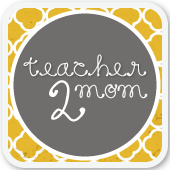Many of you moms out there have toddlers at home...not quite ready for preschool, but they still have the urge to learn. One of my friends has a 2 1/2 year old little one at home and she wrote me asking for ideas on how to keep him busy, engaged, and learning at home. I have been brainstorming these past few days and have compiled a list of hopefully
FUN, ENGAGING, & FREE activities that you too can do at home with your toddler!
WAYS TO HAVE FUN & LEARN WITH TODDLERS
(at home or on the road)
1. When it's time to clean up toys or clutter make it into a game! Have some music ready to play (Mama J and I are working on a fun playlist of songs that you can sing, dance, and listen to with your kids. We will be sharing this soon!) Ask your child to sort his toys by shape, color, or size into different areas (baskets, spots on the floor, bins, etc.) Tell him that when the music starts you will begin sorting the items together. *You can make it into a race if your child is motivated by that or just have fun doing it together. After he has sorted the items ask him questions about the toys, "Why did you make this pile?", "How many things are in this bin?", or "What other ways can we sort our toys?". This can be a GREAT learning experience and a fun way to clean up.
2.
What child does not love to go on
TREASURE HUNTS?! Take a trip to the park or even a ride in the car (really this activity can be done anywhere). Today we are going to the park with a 2 1/2 year-old Laura. I explain to Laura in the car that we are going to go on a treasure hunt for all different things while we at the park. This is a treasure hunt with our
EYES & HANDS, that's all you will need! Sounds fun, huh? When we get to the park I proceed to ask her to find the following by running around and touching them with her hands and seeing them with her eyes.
1. Anything that is ROUND.
2. Only things that are the color RED.
3. Touch all the things in the park that are the shape of a square.
You get the idea.
To make this game even more exciting you can switch up the body parts that she needs to touch things with. Or rather than use the sense of touch, use the sense of smell! There are SO many ways to make treasure hunts fun.
Those are two ideas for now...many more to come!





































